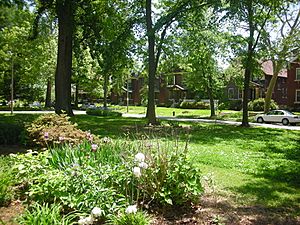Carondelet, St. Louis facts for kids
Quick facts for kids
Carondelet
|
|
|---|---|
|
Neighborhood of St. Louis
|
|

Private residences along a traffic island in Carondelet.
|
|

Location (red) of Carondelet within St. Louis
|
|
| Country | United States |
| State | Missouri |
| City | St. Louis |
| Wards | 1, 3, 8 |
| Area | |
| • Total | 1.45 sq mi (3.8 km2) |
| Population
(2020)
|
|
| • Total | 7,734 |
| • Density | 5,334/sq mi (2,059/km2) |
| ZIP code(s) |
Parts of 63111
|
| Area code(s) | 314 |
| Website | stlouis-mo.gov |
Carondelet is a historic neighborhood located in the very southeastern part of St. Louis, Missouri. It started as an independent city in 1851. Later, in 1870, it became part of the City of St. Louis. As of 2020, about 7,734 people live in Carondelet.
Contents
What's in a Name?
Carondelet was named after Baron Carondelet. He was the governor of the Spanish colony called Upper Louisiana a long time ago.
This community had many different names and nicknames over the centuries. Some of these included Delor's Village, Catalan's Prairie, Louisbourg, Vide Poche, and Sugarloaf. Each name tells a little bit about its past.
The Story of Vide Poche
One interesting nickname for Carondelet was "Vide Poche." This French phrase is often thought to mean "empty pocket." One story says that people from Carondelet often couldn't pay for flour they bought from St. Louis. Their pockets were empty!
Another idea is that "Vide Poche" meant "empties pocket." This could mean that visitors to Carondelet would spend all their money there. The people of Carondelet were known for being friendly and enjoying sports and games. Maybe they were just better at cards or had faster horses!
It's also believed that "Vide Poche" might have originally meant "the mill." This is because a mill was located in the area when the village first started.
A Look at Carondelet's History
Carondelet was founded in 1767 by a man named Clément Delor de Treget from France. He built a stone house, and the village was first known as Delor's Village.
Later, it was called Catalan's Prairie, named after an early settler, Louis Catalan. The name Louisbourg likely honored King Louis XVI of France.
Becoming Part of St. Louis
Carondelet officially became a city in 1832. It merged with a part of St. Louis in 1860, and then fully joined the city in 1870.
Important Firsts and Industries
The Sisters of St. Joseph of Carondelet, a religious group with French origins, started their first American foundation here in 1836.
Carondelet also played a big role in processing lead from nearby mining areas. This started in the 1840s, with lead being shipped in by train.
A very important event happened in Carondelet in 1873. Susan Blow started the first public kindergarten in the United States at Des Peres School. This was a big step for early childhood education!
Carondelet During the Civil War
During the American Civil War, Carondelet was a busy place for building ships. The Union Marine Works shipyards, owned by James Buchanan Eads, built 32 ironclad gunboats for the Union Army and Navy.
These included famous ships like the St. Louis, Carondelet, Pittsburgh, and Louisville. These powerful ships helped the Union forces during the war.
Carondelet Today
The neighborhood was first settled by French people, and later by German immigrants. Today, Carondelet has a mix of different uses. Along the Mississippi River, you'll find industrial areas. Away from the river, there are homes and businesses.
Carondelet has some of the oldest homes in St. Louis. This is because it was once its own independent village. Most of the houses were built between 1880 and 1930. You can find everything from small cottages to larger family homes, mostly made of brick.
Who Lives in Carondelet?
In 2020, Carondelet's population was made up of different groups. About 43.1% were White, 39.3% Black, 0.5% Native American, 1.5% Asian, 9.9% Two or More Races, and 5.6% Some Other Race. About 9.6% of the people were of Hispanic or Latino background.
| Historical population | |||
|---|---|---|---|
| Census | Pop. | %± | |
| 1990 | 9,417 | — | |
| 2000 | 8,930 | −5.2% | |
| 2010 | 8,661 | −3.0% | |
| 2020 | 7,734 | −10.7% | |
| Sources: | |||
Images for kids


